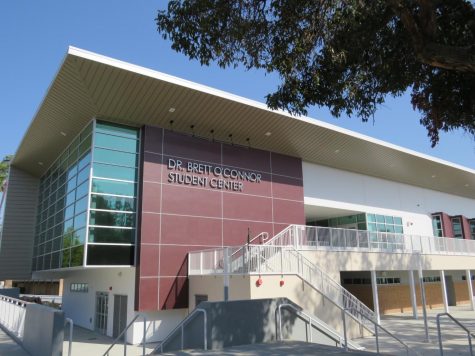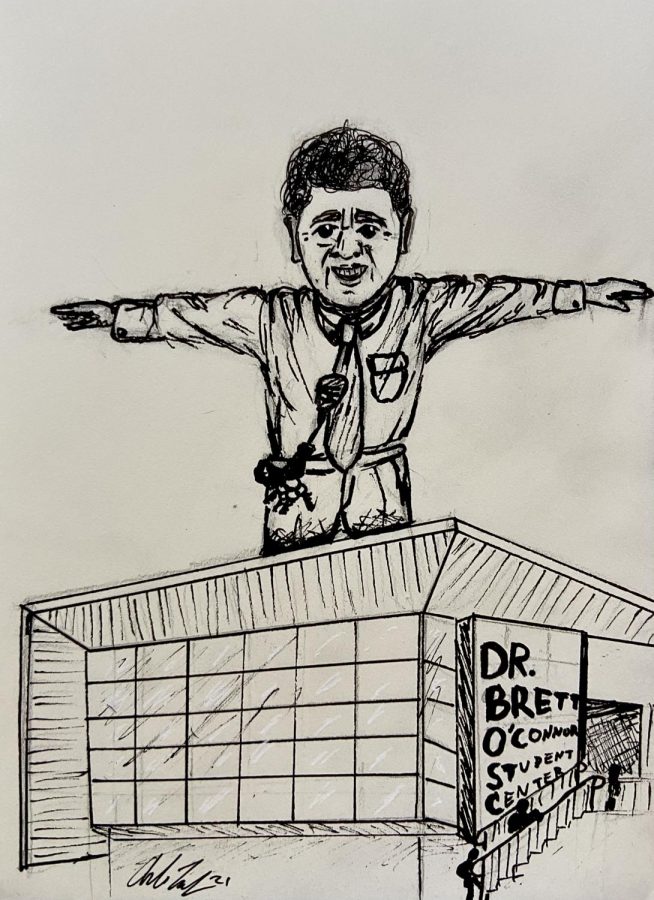Satire: Choice to name student center after O’Connor is flawed
It is clear that CHS has grown and been enriched under the 13-year stewardship of Dr. Brett O’Connor; yet, analogizing the school to a ship navigating the ocean, should the ship’s captain receive recognition for its achievements, or should the crew? The first mate, or the admiral on land who charted the voyage? The ship itself, in its material, inherent stewardship? Or the currents which propelled it to victory? Perhaps those who built the ship or those who mentored its crew members merit recognition. In the christening of a landmark which is meant to embody progress for an institution, naming is arbitrary. One person who furthered institutional excellence, one positive attribute of the organization, one source of luck or success, is memorialized, while other equally deserving possibilities are cast aside.
In the context of the Dr. Brett O’Connor Student Center, built with funding allocated to the school by Measure G, although O’Connor was “deserving” of the title of the student center, there were countless other possibilities for the building’s name: Tob Rhomas Student Center, Center for NSieg Stan Students, Kevin Glavin Student Center, [Petti-]Bone Zone, and Center for Students and Casa de Casas. There are also many more valid possibilities, too many to add to this piteously short list; and all of these improved names would make students, faculty, and staff alike proud to be associated with the shining, monumental edifice in the heart of campus. According to CUSD Board President Nancy Treser Osgood, however, the current name was recommended unanimously by the Measure G Citizen’s Oversight Committee: (and they should not be blamed for their blunder). The CUSD Board then approved the name on May 21 of last year in a 5-0 vote, Osgood reports, (and the board, too, cannot be put to fault). They simply are unfamiliar with the ship’s crew and voyage and know only its captain. The naming was not a matter of ignorance but a matter of convenience and circumstance, and anyone in the committee’s and board’s positions would have done the same.
Nonetheless, the school board should have opened up the decision-making process to the general CHS campus rather than snub democracy in an oligarchical manner under the guise of a representative system. Why?
Returning to the assertion introduced above, every name, feature, and changemaker is equally deserving of acknowledgement. However, only one can be chosen. The solution to this quandary is to cast aside semantic meaning in favor of selecting a name solely based on its phonetic, rhetorical, or aesthetic value. Such a method prioritizing the value inherent in the name eschews personal biases toward an individual person or characteristic with infinite, equally worthy counterparts.
In the case of the Dr. Brett O’Connor Student Center, which is now a sequence of words painful even to type, the name has virtually no phonetic value; it revolts the vocal cords; however much meaning it holds because of the actions of its owner, taken at face value, the name is loathsome. Even a wolfpack pun would have been a more attractive phonetic and rhetorical alternative: reuse “Wolf Den” for all I care. With so many equally meaningful alternatives, five seconds suffice to think of a more agreeable name.

Furthermore, with no offence intended to the parents of Claremont’s T-posing figurehead and steward, who (on Earth, in this day and age) would name their child Brett? Similarly, the student body and Claremont community would never name a new building Brett, if given the choice — not because of any unfavorable aspect of O’Connor’s person, rather, unfortunately, because of the abhorrent phonetic and aesthetic nature of the name.
The monosyllabic nature of the name and the abrupt sounds of the “b” and “t”s deemphasize hearty vowel sounds (i.e. the lone vowel “e” in this case) which often give names character and beauty. Take the name of cross-country coach Bill Reeves, for instance: in “Bill,” pronounced in standard Southern Californian English, the vowel “i,” despite only representing 25% of the written word, produces gratifying vowel sounds which outlive itself, lasting into the double “l” which marks the end of the name; the double “e” in “Reeves” also gives the name depth and character. In both name and surname, vowels and consonants work in harmony to augment phonetic value. In “Brett,” on the other hand, consonants crowd and overpower the solo “e;” this struggle is apparent to the speaker, as the name goes quickly, without a second thought, in a dull, monosyllabic fashion. Given the manifest flaws of “Brett,” it is not necessary to outline the shortcomings of “O’Connor” in a similar process examining its aesthetic value.
When walking past the Dr. Brett O’Connor Student Center for the first time, every CHS student cringed, experiencing pangs of heartache at what could have been, and lamenting the dystopian naming of the building while imagining utopias of hope — societies which do not choose “Brett.” Given the equal semantic value of all choices in the naming of the student center, the abysmal sound of “Brett” brings to light the unequal phonetic value of choices. Thus, it is of utmost importance to the school to reconsider the naming of the student center. If it is impossible for the district to choose another, more appealing, name, annulling the current name would be the most reasonable course of action.
Hello there! Our goal is to provide relavent, engaging journalism for readers of all ages. Your donation will support the student journalists of the Wolfpacket at Claremont High School, and will allow us to purchase equipment, print our monthly issues, and enter in journalism competitions. We appreciate your consideration!

A senior in his third year on the Wolfpacket staff, Rowan Orlijan-Rhyne, occasionally referred to as Rowan “Orange Rind” by his Wolfpacket peers, strives...















